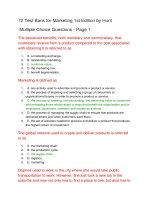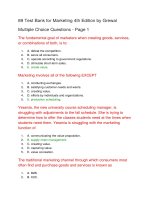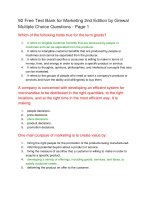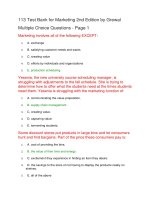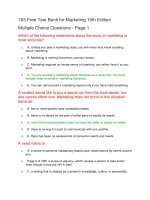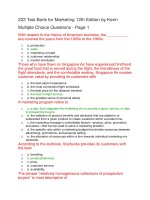117 test bank for marketing 3rd edition
Bạn đang xem bản rút gọn của tài liệu. Xem và tải ngay bản đầy đủ của tài liệu tại đây (184.06 KB, 38 trang )
117 Test Bank for Marketing 3rd Edition
by Grewal Mutiple Choice Questions - Page 1
Brian is struggling with the choice of publishing his new book, "How
to cook Polish Barbeque" as an e-book or a paperback. Brian is
addressing which core marketing aspect?
1.
A. Developing a promotional plan.
2.
B. Managing the Exchange function of marketing.
3.
C. Making product decisions.
4.
D. Deciding where and how to sell the product.
5.
E. Pricing the product.
Julia is considering a career in marketing. She is concerned about
the image of marketers as fast- talking, high-pressure people. When
reading about the core aspects of marketing, Julia is relieved to see
that in marketing:
1.
2.
A. all parties to an exchange should be satisfied.
B. promotion is the most important consideration, followed by pricing
decisions.
3.
C. decisions are made regarding how a product is designed.
4.
D. customers are not considered until the product is ready for sale.
5.
E. distribution is controlled by customers.
Marketers involved in supply chain management are constantly
balancing the:
1.
A. goal of promotional effectiveness against ethical advertising standards.
2.
B. problem of price maximization against cost efficiency.
3.
4.
C. goal of minimizing costs against satisfying the service levels customers
expect.
D. desire to achieve against the need for a stable source of supply.
5.
E. goal of efficiency against the price charged by competitors.
Marketing involves all of the following EXCEPT:
1.
A. conducting exchanges
2.
B. satisfying customer needs and wants
3.
C. creating value
4.
D. efforts by individuals and organizations
5.
E. production scheduling
Which of the following is a core aspect of marketing?
1.
A. Satisfying as many needs as possible.
2.
B. Creating a product that everyone will want to buy.
3.
C. Setting prices lower than all competitors.
4.
D. Making product, place, promotion, and price decisions.
5.
E. All of these.
Marketing includes offering:
1.
A. goods.
2.
B. services.
3.
C. ideas.
4.
D. goods, services, and ideas.
5.
E. goods and services only.
Which of the following questions must be addressed when making
marketing decisions?
1.
A. How is the product to be designed?
2.
B. How much should the product cost?
3.
C. Where should the product be promoted?
4.
D. How will the product be delivered to the customer?
5.
E. All of these
Local television advertising often includes ads for automobiles
dealerships using actors trying to create a sense of excitement and
urgency among consumers. These ads are attempting to achieve
the promotional goal of _____________ potential buyers.
1.
A. informing
2.
B. persuading
3.
C. reminding
4.
D. all of these
5.
E. none of these
Whenever Valerie has a new massage therapy customer, she
invites the person to be on her e-mail distribution list. In the
process, in addition to exchanging her massage therapy service for
payment, Valerie is gathering:
1.
A. information.
2.
B. promotional capital.
3.
C. pricing data.
4.
D. value cocreation.
5.
E. all of these.
The four Ps comprise the marketing mix, which is the
______________ set of activities that the firm uses to respond to
the wants of its target markets.
1.
A. unpredictable
2.
B. external
3.
C. internal
4.
D. controllable
5.
E. global
Jami sells construction equipment. Whenever she calls on her
building contractor customers, she asks if they are having any
problems. In doing so, Jami is addressing which of the following
core aspects of marketing?
1.
A. Satisfying customer needs and wants
2.
B. The exchange function of marketing
3.
C. Product, place, promotion, and price decisions
4.
D. Decisions regarding in which setting marketing takes place
5.
E. Creating value
Xavier is analyzing potential market segments. He should carefully
seek potential customers who have both an interest in his products
and:
1.
A. a thorough knowledge of his brand messages.
2.
B. the ability to buy them.
3.
C. knowledge of competing products.
4.
D. the ability to negotiate discounts.
5.
E. are removed from traditional marketing alternatives.
Supply chain management involves integrating the efforts of:
1.
A. suppliers.
2.
B. manufacturers.
3.
C. warehouses.
4.
D. stores.
5.
E. All of these.
When referring to "exchange," marketers are focusing on:
1.
A. the location where products and services are traded.
2.
B. the price charged, adjusted for currency exchange rates.
3.
C. location-based tactics for creating value.
4.
D. promotional offers designed to stimulate barter.
5.
E. the trading of things of value.
Marketing efforts designed to get the product or service to the right
customer, when that customer wants it, are called:
1.
A. supply chain management.
2.
B. a transactional orientation.
3.
C. wholesaling.
4.
D. value cocreation.
5.
E. endless chain marketing.
Every Christmas season, Anheuser-Busch runs television ads
featuring Clydesdale horses in a winter scene. These ads focus on
the promotional goal of __________ consumers about Budweiser,
the company's brand of beer.
1.
A. informing
2.
B. persuading
3.
C. reminding
4.
D. all of these
5.
E. none of these
The price of a product:
1.
A. is usually expressed in terms of money.
2.
B. includes the time involved in the purchase decision.
3.
C. includes the effort and energy involved in researching the product.
4.
D. is everything the buyer gives up to obtain the product.
5.
E. all of these
Of primary interest to marketers are ___________________
buyers.
1.
A. centrally controlled
2.
B. unqualified and underserved
3.
C. qualified potential
4.
D. first-time
5.
E. C2C
Fiona has developed a new software application that automatically
recalculates and reformats accounting information based on the
standards used in each country. Her product is superior to anything
that exists on the market. Which of the following questions will she
have to address when making marketing decisions?
1.
A. How the software will be promoted?
2.
B. What price should she charge?
3.
C. Should she sell her software on the Internet?
4.
D. In what country should she offer the software for sale first?
5.
E. All of these
When a tee shirt manufacturer states, "We only sell it in black
because that way we can buy plenty of black fabric and run our
plant efficiently," their statement reflects the views that were
popular in which era of the evolution of marketing?
1.
A. Production-oriented
2.
B. Sales-oriented
3.
C. Market-oriented
4.
D. Value-based marketing
5.
E. Economic-oriented
Some discount stores put products in large bins and let consumers
hunt and find bargains. The price these consumers pay includes:
1.
A. only the actual price they pay at the register.
2.
B. the value of their time and energy.
3.
C. the excitement they experience in finding an item they desire.
4.
5.
D. the savings to the store of not having to display the products neatly on
shelves.
E. all of these
The basic difference between a good and a service is that a good:
1.
A. provides intangible benefits.
2.
B. can be physically touched.
3.
C. is always less expensive than a corresponding service.
4.
D. generates greater interest among consumers.
5.
E. is more quickly forgotten by consumers.
The marketing goal of getting the "right quantities to the right
locations, at the right time" is:
1.
A. communicating the value proposition.
2.
B. supply chain management.
3.
C. creating value.
4.
D. capturing value.
5.
E. price and performance management.
Henriette offers financial counseling and management on a fee-only
basis. She has found that different customers are willing to pay
different rates for her services. This shows that her pricing
decisions should depend primarily on:
1.
A. regulations determining the maximum fees financial advisors can charge.
2.
B. changes in technology allowing consumers to manage their own affairs.
3.
C. how different customers perceive the value of her services.
4.
D. changes in the economy.
5.
E. how much effort it takes to serve different types of clients.
Delivering the value proposition is also known as:
1.
A. endless chain marketing.
2.
B. a transactional orientation.
3.
C. wholesaling.
4.
D. product design.
5.
E. supply chain management.
Yesenia, the new university course scheduling manager, is
struggling with adjustments to the fall schedule. She is trying to
determine how to offer the classes students need at the times when
students need them. Yesenia is struggling with the marketing
function of:
1.
A. communicating the value proposition.
2.
B. supply chain management.
3.
C. creating value.
4.
D. capturing value.
5.
E. value cocreation.
When considering career choices in marketing, many students
overlook supply chain management because:
1.
A. it is considered too quantitative.
2.
B. marketing has no responsibility for supply chain management.
3.
C. companies generally outsource these activities, and so there are rarely
supply chain jobs available.
4.
D. it only takes place in large, urban areas.
5.
E. many of the activities take place behind the scenes.
UPS washes its trucks nightly so they are always clean, and
requires its delivery people to wear clean, unwrinkled uniforms.
UPS probably established these rules because they know that:
1.
A. consumers want friendly delivery people.
2.
B. most delivery services do not require uniforms.
3.
C. consumers' judgment of the benefits they receive from services are tied to
the image of the producer.
4.
D. the goods UPS sells are easily replicated.
5.
E. all of these
Marketing traditionally has been divided into a set of four
interrelated decisions known as the marketing mix, or four Ps,
including all of the following EXCEPT:
1.
A. product
2.
B. place
3.
C. performance
4.
D. promotion
5.
E. price
The owner of The Pipe Doctor, a plumbing service, often orders the
sinks, faucets, and toilets he installs for his customers. Since he is
paid for these items and also for the labor to install them, the Pipe
Doctor:
1.
A. is a provider of goods.
2.
B. is a service provider.
3.
C. provides both goods and services.
4.
D. is primarily a marketer of ideas.
5.
E. offers neither goods nor services.
Four Winds Art Gallery recently began offering appraisals of
customers' art collections, in addition to continuing to sell paintings.
Four Winds is:
1.
A. expanding from offering just services to also offering goods.
2.
B. implementing a market segmentation strategy.
3.
C. capturing value through multiple pricing strategies.
4.
D. expanding from offering just goods to also offering services.
5.
E. increasing customer value through inflated appraisal evaluations.
________________ is communication by a marketer that informs,
persuades, and reminds potential customers about a product to
influence their opinions and elicit a response.
1.
A. Pricing
2.
B. Promotion
3.
C. Placement
4.
D. A relational orientation
5.
E. Value cocreation
The importance of supply chain management is often overlooked in
the study of marketing because:
1.
A. marketing has no responsibility for supply chain management.
2.
B. supply chain management doesn't add much value for customers.
3.
4.
C. companies do not want customers to know anything about the supply
chain.
D. many of the activities take place behind the scenes.
5.
E. all of these.
Effective promotion enhances a product or service's:
1.
A. supply chain management system.
2.
B. wholesaling capabilities.
3.
C. perceived value.
4.
D. design features.
5.
E. all of these.
The goal of promotion is to _______________ potential buyers
about a product or service.
1.
A. inform
2.
B. persuade
3.
C. remind
4.
D. all of these
5.
E. none of these
UPS, FedEx, DHL, and other shipping companies support other
firms'________________ marketing goals.
1.
A. supply chain management
2.
B. value communication
3.
C. value capture
4.
D. retail management
5.
E. none of these
Marketers must determine the price of a product carefully on the
basis of the potential buyers' beliefs about:
1.
A. its value.
2.
B. the environment.
3.
C. the cost to manufacture the product.
4.
D. the economic outlook.
5.
E. the product's new advertising campaign.
The fundamental goal of marketers when creating goods, services,
or combinations of both, is to:
1.
A. defeat the competition.
2.
B. serve all consumers.
3.
C. operate according to government regulations.
4.
D. stimulate short-term sales.
5.
E. create value.
117 Free Test Bank for Marketing 3rd Edition by Grewal
Mutiple Choice Questions - Page 2
In the past, manufacturer's representatives did not have up-tominute data about the products they were selling. Today,
manufacturer's representatives are often provided online access to
inventory data for the companies they represent. These online
inventory systems allow companies to become more value driven
through:
1.
A. sharing information across the organization.
2.
B. balancing customers' benefits and costs.
3.
C. evaluating strategic competitive partnerships.
4.
D. building relationships with government regulators of marketing institutions.
5.
E. keeping prices below those charged by competitors.
Value-based marketing depends on:
1.
A. knowing what the customer perceives as the key benefits of a product or
service.
2.
B. balancing customer benefits with reasonable costs.
3.
C. knowing what benefits customers would do without to keep prices down.
4.
D. looking at quality from the customer's perspective.
5.
E. All of these.
Valerie's firm researched what its employees wanted from their
jobs. It then communicated a brand image for the firm and worked
to ensure that the employees' experiences matched what was
advertised. The firm is using:
1.
A. human resources marketing.
2.
B. employee relations mediation.
3.
C. human factors analysis.
4.
D. employment marketing.
5.
E. human asset branding.
During the ______________ era, firms had excess capacity and
used personal selling and advertising to generate customers.
1.
A. production
2.
B. sales
3.
C. marketing
4.
D. value-based marketing
5.
E. retailing
As owner of a retail franchise food store, Mary Gray purchases
supplies based on specials advertised nationally throughout the
franchise system. One Monday, she was surprised to find
customers asking for specials she hadn't been informed of in
advance. The franchise company failed to live up to the valuedriven principle of:
1.
A. sharing information across the organization.
2.
B. balancing customers' benefits and costs.
3.
C. evaluating strategic competitive partnerships.
4.
D. building relationships with customers.
5.
E. keeping prices below those charged by competitors.
In delivering value, marketing firms attempt to find the most
desirable balance between:
1.
A. the need for value and the perception of value.
2.
B. explicit versus implicit value.
3.
C. providing benefits to customers and keeping costs down.
4.
5.
D. the desire to satisfy customers and the need to keep customers from
running the company.
E. the need for product improvement and the need for advertising.
Many U.S. companies first discovered marketing during the
_________ era.
1.
A. production
2.
B. sales
3.
C. marketing
4.
D. value-based marketing
5.
E. retailing
Many universities provide physical or electronic bulletin boards to
facilitate ride-sharing and exchange of used books among students.
These bulletin boards increase _________ marketing.
1.
A. B2C
2.
B. C2B
3.
C. B2B
4.
D. C2C
5.
E. underground
Some consumers will try to get a lot of merchandise for a small
amount of money. In marketing, this is known as:
1.
A. the marketing paradox.
2.
B. the outer limits of pricing
3.
C. customers seeking value.
4.
D. excess valuation.
5.
E. marketing myopia.
One of the benefits of value-driven marketing is that attention to
customer needs and wants will likely result in:
1.
A. higher prices than the market leader charges.
2.
B. increased competition.
3.
C. long-term loyalties.
4.
D. strong connections among competing firms in the marketplace.
5.
E. all of these.
Value-driven firms constantly measure the ___________ that
customers perceive, compared to the prices of their offerings.
1.
A. information
2.
B. benefits
3.
C. relationships
4.
D. rebates
5.
E. merchandise
BestBulk clothing store is striving to become a more value-driven
organization. Its managers should ensure that the staff shares
information about:
1.
A. customers
2.
B. competitors
3.
C. complaints
4.
D. inventories
5.
E. all of these
Retailers accumulate merchandise from producers in large amounts
and sell to consumers in smaller amounts. Retailers function as:
1.
A. market intermediaries.
2.
B. monopolists.
3.
C. regulators of consumer demand.
4.
D. wholesale specialists.
5.
E. intermediate promoters.
The "Got Milk" advertising campaign, designed to increase
consumption of milk, was intended to help market a(n):
1.
A. individual.
2.
B. firm.
3.
C. industry.
4.
D. organization.
5.
E. all of these.
The evolution of marketing progressed along the following
continuum:
1.
A. sales, marketing, value-based marketing, production
2.
B. marketing, value-based marketing, production, sales
3.
C. value-based marketing, production, sales, marketing
4.
D. production, sales, marketing, value-based marketing
5.
E. sales, value-based marketing, marketing, production
The traditional marketing channel through which consumers most
often find and purchase goods and services is known as:
1.
A. B2B
2.
B. C2C
3.
C. D2C
4.
D. C2D
5.
E. B2C
During the marketing era:
1.
A. a good product would sell itself.
2.
B. the customer was king.
3.
C. marketing was more important than production.
4.
D. advertising and personal selling were emphasized to make the sale.
5.
E. firms focused on value.
Janine has a new clothing design she would like to market, but she
knows that creating and delivering value to consumers is a
challenge. She has seen other designers' successful products
copied by other firms soon after they were introduced. For Janine,
the major problem she faces in creating and delivering value is
probably that:
1.
A. consumer perceptions change quickly.
2.
B. competitors constantly enter markets.
3.
C. global pressures continually reshape market opportunities.
4.
D. marketers' understanding of consumers is complete.
5.
E. consumers do not know what they want.
Even though they operate from out-of-the-way airports and offer few
extra services, discount airlines like Ryanair and EasyJet have
been successful. Consumers obviously consider:
1.
2.
3.
4.
5.
A. the schedules these airlines offer to be the most convenient in the industry.
B. the long-term relationships established by these airlines to be a critical
benefit.
C. the prices to be slightly lower, but not low enough to have much influence.
D. the benefit of lower prices to be greater than the cost of reduced services
and less convenience.
E. the major airlines to be worthless.
Auction sites like eBay have increased opportunities for ________
marketing.
1.
A. B2B
2.
B. C2C
3.
C. D2C
4.
D. C2D
5.
E. B2C
During the ____________ era manufacturers and retailers
recognized they needed to give their customers greater value than
their competitors did.
1.
A. production
2.
B. sales
3.
C. marketing
4.
D. value-based marketing
5.
E. all of these
As use of the Internet took off, car manufacturers were tempted to
sell directly to consumers, but decided to maintain their existing
dealer networks. The car manufacturers considered switching from
_____ to _____ marketing.
1.
A. B2C; B2B
2.
B. B2C; C2C
3.
C. B2B; B2C
4.
D. B2B; C2C
5.
E. C2C; B2C
In 2006, the film "Supersize Me" provided a critical view of
McDonald's and its products that caused some consumers to stop
eating at McDonald's. The company was caught off guard and had
to move quickly to develop a response. In terms of value-based
marketing, McDonald's faced what potential problem?
1.
A. Consumer perceptions change quickly.
2.
B. Competitors constantly enter markets.
3.
C. Global pressures continually reshape market opportunities.
4.
D. Marketers' understanding of consumers is complete.
5.
E. Consumers do not know what they want.
Which of the following is NOT true about marketing ideas?
1.
2.
A. Opinions, philosophies, intellectual concepts and even thoughts can be
effectively marketed.
B. The marketing of ideas does not involve true exchange of value.
3.
C. Ideas can be "purchased" by convincing someone to change his or her
behavior.
4.
D. Marketing can be directed toward primary and secondary targets to
increase knowledge and change behavior.
5.
E. Value can be created through changing behaviors.
The idea that a good product will sell itself is associated with the
_______________ era of marketing.
1.
A. production
2.
B. sales
3.
C. marketing
4.
D. value-based marketing
5.
E. retailing
To become value-driven, firms should:
1.
A. share information across the entire organization about customers and
competitors.
2.
B. prioritize relationships with customers above individual transactions.
3.
C. balance benefits with costs to create value for customers.
4.
D. All of these.
5.
E. None of these
The prevailing marketing strategy of the ______________ era was
to find customers for inventories that went unsold.
1.
A. production
2.
B. sales
3.
C. marketing
4.
D. value-based marketing
5.
E. retailing
Near the end of the model year, Move-Them-Out automobile
dealership had an unusually high inventory level. The manager
increased her advertising spending and gave extra incentives to its
salespeople. Move-Them-Out operates as if it were in the
__________ era.
1.
A. production
2.
B. sales
3.
C. marketing-oriented
4.
D. value-based
5.
E. retailing
Joseph is about to graduate near the top of his class and has been
looking at some forward-thinking firms. He had expected the job
market to be tight, but found that some firms were using
employment marketing to attract the candidates they want and
need. He noticed these firms used all of the following approaches
EXCEPT:
1.
A. using marketing research to understand what future employees want from
a position.
2.
B. using advertising agencies to focus creatively on the targeted job seekers.
3.
C. developing an employee-oriented brand image.
4.
D. assuming that the right candidates will learn about the firm and apply for
jobs without any encouragement.
5.
E. working to ensure the employment experiences match the candidates'
expectations.
Yolanda is the new restaurant manager in a major hotel. When
considering changes in the restaurant to improve benefits to
customers, Yolanda will likely attempt to either provide the same
quality at a lower cost or:
1.
A. improve products and services at the same cost.
2.
B. increase prices to increase revenue.
3.
C. offset higher hotel rates with lower restaurant prices.
4.
D. reduce customer expectations through reduced service.
5.
E. any of the above.
By promoting perfume based on youth, style, and sex appeal,
Calvin Klein is attempting to:
1.
A. influence social norms regarding sexuality.
2.
B. encourage consumers to participate in product redesign.
3.
C. stimulate supply chain management cooperation.
4.
D. increase the perceived value of their products.
5.
E. none of these.
To become a more value driven organization, Pokrah University is
holding regular coffee-hour discussions with its students and is
surveying its graduates regarding students' educational needs and
desires. Pokrah University is becoming more value driven through:
1.
A. sharing information across the organization.
2.
B. balancing their customers' benefits and costs.
3.
C. evaluating strategic competitive partnerships.
4.
D. building relationships with customers.
5.
E. keeping the faculty members happy.
During the ____________ era manufacturers and retailers began to
focus on what consumers wanted and needed before they
designed, made, or attempted to sell their products.
1.
A. production
2.
B. sales
3.
C. marketing
4.
D. value-based marketing
5.
E. all of these
Value is:
1.
A. the lowest cost option.
2.
B. represented by brand names.
3.
C. the highest priced alternative.
4.
D. everyday low prices.
5.
E. what you get for what you give.
Henry Ford's statement, "Customers can have any color they want
so long as it's black," typified the ____________ era of marketing.
1.
A. production
2.
B. sales
3.
C. marketing
4.
D. value-based marketing
5.
E. retailing
Trey sells consumer electronics. He knows his customers weigh the
costs versus the benefits associated with the different options
available. He decides which products to offer and what prices to
charge based on the way his customers think. Trey operates in the
_________ marketing era.
1.
A. production
2.
B. sales
3.
C. marketing
4.
D. value-based
5.
E. retailing
Christie has just started with a travel agency, and she has been
offering clients and prospective clients a range of packaged tours.
She is concerned, because the commissions she is earning on her
sales are lower than she had hoped. Her colleague Peter, who has
been with the agency for several years, is having a great deal of
success by working closely with the clients, taking their suggestions
and building customized tour packages for each one. Peter's
approach is based on:
1.
A. transaction-oriented marketing.
2.
B. premium pricing.
3.
C. his seniority at the firm.
4.
D. special incentives from tour operators.
5.
E. value cocreation.
Melanie works for a small computer software company. Her boss is
constantly improving their products but neglecting customers,
billing, and promoting the company. Her boss is probably stuck in
the _____________ era of marketing.
1.
A. production
2.
B. sales
3.
C. marketing
4.
D. value-based marketing
5.
E. retailing
Serena studies her customer profiles, market research data,
complaints, and other information attempting to better understand
what her customers want. Serena operates in the __________ era
of marketing.
1.
A. production
2.
B. sales
3.
C. marketing
4.
D. value-based marketing
5.
E. retailing
117 Free Test Bank for Marketing 3rd Edition by Grewal
Mutiple Choice Questions - Page 3
If you are involved in a buying or selling situation in which you do
not expect to do business with the other party again, you are
engaged in a(n):
1.
A. transaction.
2.
B. negotiation.
3.
C. relationship.
4.
D. C2C channel.
5.
E. marketing mix.
Franco uses a database software system to remind him when his
customers should be ready to re-order his industrial cleaning
products. With this reminder system, Franco contacts his customers
when they are most likely to be "in the buying mode." Franco's
system is part of:
1.
A. C2C marketing.
2.
B. customer relationship management.
3.
C. a transactional marketing orientation.
4.
D. supply chain management.
5.
E. typical production era marketing practices.
Melinda, a marketing executive, is trying to explain customer
relationship management (CRM) to her parents. She explains that
CRM is a way of thinking that translates into
___________________ to identify and build long-term relationships
with her customers.
1.
A. a set of strategies
2.
B. programs

